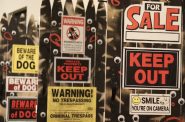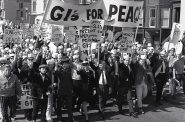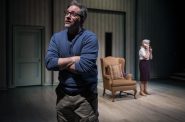Two Photographers Who Speak As One
Shimon and Lindemann lovingly and wittily capture regional Wisconsin subjects, in a must-see exhibition.
I love art that’s evocative. I love art that’s complicated, with layers of meaning. I love art with a sense of humor.
The current show at MOWA by Shimon and Lindemann, two of the most famous artists ever to come out of Manitowoc, Wisconsin, has all that and more. Yet I had resisted their work over the years. Maybe because I had only seen it in bits and pieces and small shows over the past 30 years. Or maybe I was reacting to the “coolness” of the scene that surrounded the artists, and that made it seem somehow imbedded in the 1980’s.
Seeing this retrospective, though, makes me realize how wrong I was. The Museum of Wisconsin Art has mounted a wonderful retrospective of their work that allows one to see the many aspects of their work, how it has developed and strengthened over time, and their immersion in and love of Wisconsin rural culture. It may be the latter quality of their work that I’d missed in the past. You leave this show moved by the decades of work produced through such dedication to finding the extraordinary in the ordinary.
John Shimon (b. 1961) and Julie Lindemann (b.1957) both came from farms near Manitowoc, WI. They met as undergrads in Madison, WI. He was an art student, she was a journalism student. Their first collaboration was in a rock band called Hollywood Autopsy, playing in clubs and backing up touring punk and avant garde bands passing through Madison. They even cut a record, which was re-released in 2014 as a private press record. After graduation they spent a year living in New Jersey and soaking up the art and culture in New York city. In 1984 they moved to Milwaukee and had their first major exhibit of photographs, “St. Nazianz,” which explored the small Wisconsin town Lindemann grew up in. The show included objects collected from the subjects in the photos. Shimon and Lindemann also did photo essays for several Milwaukee publications, including Art Muscle Magazine and Milwaukee Magazine.
After completing their Master’s Degree in 1989, they moved back to Manitowoc and found a 19th Century warehouse which became their studio, gallery and home. They taught at several universities and art schools and were granted tenure in 2008 at Lawrence University in Appleton. In 2011 the couple moved from Manitowoc to a farm near Appleton. Just before their exhibit at the Portrait Society in Milwaukee, Julie Lindemann was diagnosed with metastatic cancer. She is now in hospice care.
The two artists are a couple — a rather unique situation — and a true and intense collaboration. Debra Brehmer, of Portrait Society Gallery, which represents the artists and wrote an excellent essay for the show’s catalog, told me the two photographers have never spent a night apart in 30 years! They have a joint teaching position at Lawrence.
“Self-Portrait Re-Ringing the John Deere A, Whitelaw,Wisconsin” is an interior shoot with a similar effect. The couple are in a garage, amid a mis en scene with a gorgeous Baroque background of rich browns and rusts, with Lindemann in the foreground looking back at us, all translucent, with porcelain skin, blonde hair and black patent leather bra, and Shimon’s head seen below her on the other side of a farm tractor he is working on. Again, an unseen camera has taken this photo. Very beautiful, but also kind of funny; the two seem to be winking knowingly at viewers.
Their shared aesthetic has emphasized the use of antiquated photographic methods; time consuming, painstaking work sometimes using homemade cameras. They have also created 80 short films, available on YouTube, and some are in this exhibit as well. Many of their photographs have the quality of a film still. Their work has so many fun references to art history, popular culture and kitsch that add a richness.
There is a strong regionalist quality to their work; MOWA curator Graeme Reed calls it a Neo-Regionalism. This is a modernized, personalized, idiosyncratic, view of life on the farm and the small town. There’s a down home-ness of some of the images — the workers, the animals, the chores, but also an “off the grid” feeling. A lot of the subjects in these photos may have always lived here, some have left and returned, but all have chosen to be there. The result seems familiar yet slightly strange.
When Shimon and Lindemann make their portraits they ask the subject what they would like to wear; they always honor that choice and try to not impose. Their subjects are always treated with respect and grace. That’s true even of the portrait “Jimmy von Milwaukee, (Burt Reynolds Pose),” though it’s disturbing; it’s hard to look at Jimmy’s lovely body full of sarcoma lesions, and he stares unflinchingly at the camera. Yet one can sense the trust here and the knowing jest. Are the artists making “celebrities” out of ordinary folks? That’s just it, they make us question the whole concept of ordinary and average, and the celebrity idea is contradicted by the deep connection with the uniqueness of each individual. Every portrait in the section of this show entitled “Sages” captures the quirky individuality of each subject. Either through the setting, the clothing, the lighting or some less definable quality, each photo resonates with a deep connection to each sitter.
In “Angela with Kit, ( Blue Velvet Prom Dress), Reedsville, Wisconsin, 1997,” a lovely young woman stands next to her award-winning cow. The catalog from the exhibit explains that she studied dairy farming at UW- Madison and is very committed to farm life. But she shows herself in her best dress, proud, almost haughty as she looks down at us while holding her beloved, a kind of bovine goddess. The rural Wisconsinite as a sophisticate is a recurring motif in the artists’ work.
There is a strong sense of the materiality in Shimon and Lindemann’s work. They chose to create their images by using long-abandoned processes which connect to early practitioners of photography, but is also way ahead of today’s “handmade movement” which arose from a more political purpose of eschewing the corporate manufacturing of goods. Shimon and Lindemann seem to like that connection to the physical elements in photography and films. For instance, there are several gum Bichromate prints in the exhibit. A personal favorite is “Woman in White Dress,” a large, fuzzy print that harkens back to the technique used by Henry Fox Talbot and the Lumierre brothers. It’s as atmospheric as Wuthering Heights. A pale, ghostly woman (Lindemann) stands in a field near a forest. She’s the brightest spot in this charcoal-like value study. But it’s mounted on black velvet and framed in ebony with minuscule silver speckles.
Shimon and Lindemann’s work brings to mind a quote I love from 19th century French photographic pioneer Felix Nadal: “The theory of photography can be learned in an hour; the first practical notions in a day. But I will tell you what cannot be learned: it is the sense of light, the artistic appreciation of the effects produced by various combinations of light. And what can be learned even less is the moral understanding of your subject, the swift feeling that puts you in communication with the model, and enables you to make, not an ordinary plastic reproduction, which is within the reach of any laboratory workhorse, but the most familiar, sympathetic, innermost likeness.”
That moral understanding, the subtle hand of the artist, is ever present in this work, except in this case it’s four hands.
“There’s a Place: Photographs by Shimon and Lindemann,” Through June 7, Museum of Wisconsin Art in West Bend.
Art
-
Winning Artists Works on Display
 May 30th, 2024 by Annie Raab
May 30th, 2024 by Annie Raab
-
5 Huge Rainbow Arcs Coming To Downtown
 Apr 29th, 2024 by Jeramey Jannene
Apr 29th, 2024 by Jeramey Jannene
-
Exhibit Tells Story of Vietnam War Resistors in the Military
 Mar 29th, 2024 by Bill Christofferson
Mar 29th, 2024 by Bill Christofferson
Review
-
New Musical a Life and Death Comedy
![Stephanie Beschta [Mrs. McCobb] and Shayne Patrick [Mr. McCobb] in RIP – A Matter of Life and Death. Photo by Stacy Kaat (www.stacykaat.com).](https://urbanmilwaukee.com/wp-content/uploads/2024/07/WEB-6056-185x122.jpg) Jul 19th, 2024 by Dominique Paul Noth
Jul 19th, 2024 by Dominique Paul Noth
-
Ouzo Café Is Classic Greek Fare
 May 23rd, 2024 by Cari Taylor-Carlson
May 23rd, 2024 by Cari Taylor-Carlson
-
‘The Treasurer’ a Darkly Funny Family Play
 Apr 29th, 2024 by Dominique Paul Noth
Apr 29th, 2024 by Dominique Paul Noth





















In the Glory Days when I owned and edited Art Muscle Magazine, the final issue featured a Shimon/Lindemann photo. The image was of a young woman waving a flag. It was a perfect farewell moment. I’ve stopped at MOWA several times to view their exhibition, and took time to listen to the record mentioned in your article Rose. The security person who activated the
record player told me that very few took the time to listen to it. A shame, because it embodies the essence of their pun roots, roots they explored on and on Byy the way, the exhibition’s title, There’s a Place for Us, was from a hit show that lit up our world in 1961, the very year John Shimon was born.
Shimon and Lindemann very very dedicated photographers (committed to the human condition at any given time!) plus great partners, both personally and professionally! This show is a must-see! Thanks for the article, Rose!
[…] Urban Milwaukee Dial “Two Photographers Who Speak as One” May 8, 2015 by Rose […]
What a relief to read an art critic who was wrong and then right about something.
Great review.
Brilliant, Rose–thank you!